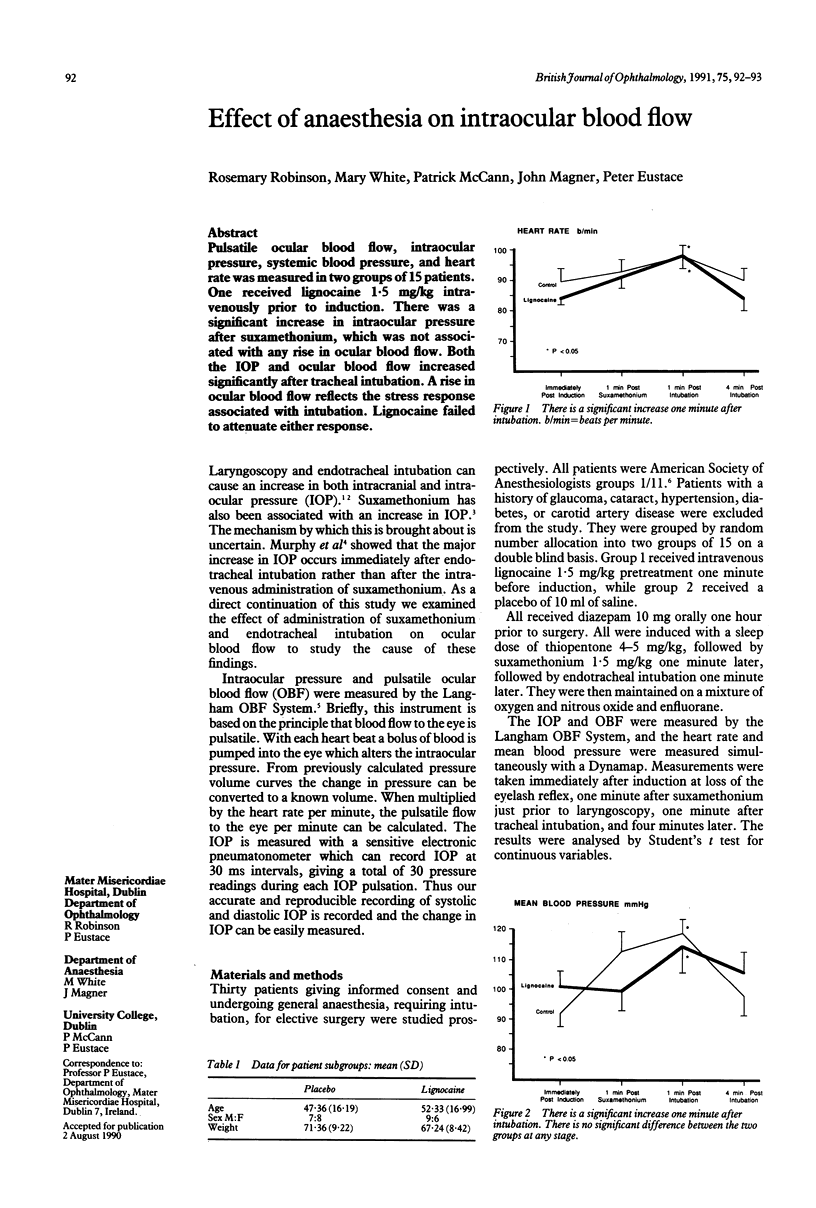Abstract
Pulsatile ocular blood flow, intraocular pressure, systemic blood pressure, and heart rate was measured in two groups of 15 patients. One received lignocaine 1.5 mg/kg intravenously prior to induction. There was a significant increase in intraocular pressure after suxamethonium, which was not associated with any rise in ocular blood flow. Both the IOP and ocular blood flow increased significantly after tracheal intubation. A rise in ocular blood flow reflects the stress response associated with intubation. Lignocaine failed to attenuate either response.
Full text
PDF

Selected References
These references are in PubMed. This may not be the complete list of references from this article.
- Adams A. K., Barnett K. C. Anaesthesia and intraocular pressure. Anaesthesia. 1966 Apr;21(2):202–210. doi: 10.1111/j.1365-2044.1966.tb02599.x. [DOI] [PubMed] [Google Scholar]
- Cook J. H. The effect of suxamethonium on intraocular pressure. Anaesthesia. 1981 Apr;36(4):359–365. doi: 10.1111/j.1365-2044.1981.tb10238.x. [DOI] [PubMed] [Google Scholar]
- Donegan M. F., Bedford R. F. Intravenously administered lidocaine prevents intracranial hypertension during endotracheal suctioning. Anesthesiology. 1980 Jun;52(6):516–518. doi: 10.1097/00000542-198006000-00014. [DOI] [PubMed] [Google Scholar]
- Drenger B., Pe'er J. Attenuation of ocular and systemic responses to tracheal intubation by intravenous lignocaine. Br J Ophthalmol. 1987 Jul;71(7):546–548. doi: 10.1136/bjo.71.7.546. [DOI] [PMC free article] [PubMed] [Google Scholar]
- LINCOFF H. A., ELLIS C. H., DEVOE A. G., DEBEER E. J., IMPASTATO D. J., BERG S., ORKIN L., MAGDA H. The effect of succinylcholine on intraocular pressure. Am J Ophthalmol. 1955 Oct;40(4):501–510. doi: 10.1016/0002-9394(55)90552-3. [DOI] [PubMed] [Google Scholar]
- Langham M. E., Farrell R. A., O'Brien V., Silver D. M., Schilder P. Blood flow in the human eye. Acta Ophthalmol Suppl. 1989;191:9–13. doi: 10.1111/j.1755-3768.1989.tb07080.x. [DOI] [PubMed] [Google Scholar]
- Meyers E. F., Krupin T., Johnson M., Zink H. Failure of nondepolarizing neuromuscular blockers to inhibit succinylcholine-induced increased intraocular pressure, a controlled study. Anesthesiology. 1978 Feb;48(2):149–151. doi: 10.1097/00000542-197802000-00013. [DOI] [PubMed] [Google Scholar]
- Murphy D. F., Eustace P., Unwin A., Magner J. B. Intravenous lignocaine pretreatment to prevent intraocular pressure rise following suxamethonium and tracheal intubation. Br J Ophthalmol. 1986 Aug;70(8):596–598. doi: 10.1136/bjo.70.8.596. [DOI] [PMC free article] [PubMed] [Google Scholar]
- Poulton T. J., James F. M., 3rd Cough suppression by lidocaine. Anesthesiology. 1979 May;50(5):470–472. doi: 10.1097/00000542-197905000-00018. [DOI] [PubMed] [Google Scholar]


